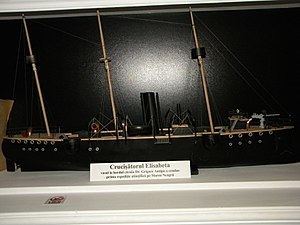In commission 1888–1920 Scrapped 1 Ordered May 1887 Launched 29 December 1887 | Completed 1 Name Elisabeta Construction started 17 May 1887 Length 73 m | |
 | ||
Namesake Queen Elisabeta of Romania | ||
NMS Elisabeta was a small protected cruiser built for the Romanian Navy during the 1880s by Armstrong in Britain as Romania lacked the ability to build the ship itself. Serving mainly as a training ship, she represented Romania at the opening of the Kiel Canal in 1895. She helped protect Romanian interests in Constantinople during the First Balkan War in 1912–13, but played no significant part in the Second Balkan War and was partially disarmed during World War I. Employed as a barracks ship after the war, the ship was scrapped in 1926.
Contents
Description
Elisabeta was built of steel and measured 240 feet (73.2 m) long overall. She had a beam of 33 feet 6 inches (10.2 m) and a draft at the bow of 11 feet 6 inches (3.5 m) that increased to 12 feet 6 inches (3.8 m) at the stern. She displaced 1,330 long tons (1,351 t) at full load. The ship had a crew of 140 officers and crewmen.
Elisabeta had two vertical triple-expansion steam engines, each driving a single 9-foot-8-inch (2.95 m) screw propellers. Four cylindrical boilers provided steam to the engines. The engines had a designed output of 3,000 indicated horsepower (2,237 kW) at normal draft for 16.5 knots (30.6 km/h; 19.0 mph) or 4,500 ihp (3,356 kW) using forced draft for 17.5 knots (32.4 km/h; 20.1 mph). During her sea trials on 14 September 1888, Elisabeta had a top speed of 18.3 knots (33.9 km/h; 21.1 mph) from 4,714 ihp (3,515 kW) using forced draft, but she averaged 18.06 knots (33.45 km/h; 20.78 mph) from 4,271 ihp (3,185 kW) using normal draft, although her main guns had yet to be installed. Her three masts were barque rigged. She carried a maximum of 322 long tons (327 t) of coal.
The ship's main armament consisted of four single 15-centimeter (5.9 in)/35-caliber Krupp breech-loading guns on pivot mounts in semi-circular sponsons on the side of the ship. She carried four single quick-firing (QF) 57-millimeter (2.2 in) Nordenfelt guns, two each in the bow and stern. She also carried a pair of QF 37-millimeter (1.5 in) Hotchkiss guns. Four 356-millimeter (14.0 in) above-water torpedo tubes were also fitted, one each in the bow and stern and one on each broadside. Her curved protective deck was 1.5 inches (38 mm) thick on the flat and increased to 3.5 inches (89 mm) on the slopes. It tapered to 1 inch (25.4 mm) at the ends of the ship. A 4-inch (102 mm) transverse bulkhead was fitted in the bow and the ship mounted a conning tower protected by 3 inches (76 mm) of armor.
Construction and career
Elisabeta was ordered in May 1887 from Armstrong and designed by Philip Watts. The ship was laid down at their shipyard in Elswick later that month on 17 May with the yard number of 517. She was launched on 29 December, and conducted her final sea trials on 19 September 1888. Elisabeta sailed for Romania at the end of October 1888, arriving there about three weeks later. After her arrival, her armament was mounted at the Galaţi shipyard because the Romanians preferred Krupp weapons and not Armstrong guns.
The ship made several summer training voyages around the Black Sea in 1889 and 1890. At the beginning of 1891 she began a five-month cruise in the Mediterranean. Elisabeta represented Romania at the 1892 Columbus celebrations of Livorno, Barcelona and Lisbon. In 1894 she made a short cruise in the Black Sea followed by a longer Mediterranean cruise. Elisabeta sailed for Kiel in 1895 to participate in the opening celebration of the Kiel Canal and continued on to Stockholm where she was inspected by the King of Sweden. She made the first Romanian survey of their coast in 1898 and underwent a major refit at Galaţi in 1904–05 where her sailing rig was reduced to two pole masts. The ship was present when the mutinous Russian battleship Potemkin arrived in Constanța in July 1905, but played no significant role in the affair.
Elisabeta's armament was exchanged for four French Saint-Chamond 120-millimeter (4.7 in) and 75-millimeter (3.0 in) guns in 1907. She was in Constantinople during the First Balkan War where she landed several shore parties to protect the Romanian Legation. After the end of the war the ship returned to Romania on 15 June 1913, only a day before Bulgaria began the Second Balkan War. Elisabeta remained at Sulina to defend the mouths of the Danube during the war. Disarmed when World War I began, her main armament was emplaced on the Danube River to protect against possible attacks by Austro-Hungarian river monitors and she remained in Sulina for the duration of the war to reinforce its anti-aircraft defenses. Elisabeta was taken out of service in 1920 and was used as a barracks ship at Galaţi and later at Sulina. She was sold for scrap in 1926.
